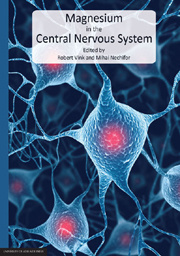Book contents
- Frontmatter
- List of Contributors
- Preface
- Contents
- Section 1 Magnesium in Normal Brain
- Chapter 1 Free magnesium concentration in human brain
- Chapter 2 Intracellular magnesium homeostasis
- Chapter 3 Magnesium transport across the blood-brain barriers
- Chapter 4 Intracellular free Mg2+ and MgATP2− in coordinate control of protein synthesis and cell proliferation
- Chapter 5 Magnesium and the Yin-Yang interplay in apoptosis
- Chapter 6 Brain magnesium homeostasis as a target for reducing cognitive ageing
- Section 2 Magnesium in Neurological Diseases
- Section 3 Involvement of Magnesium in Psychiatric Diseases
Chapter 2 - Intracellular magnesium homeostasis
from Section 1 - Magnesium in Normal Brain
Published online by Cambridge University Press: 05 June 2012
- Frontmatter
- List of Contributors
- Preface
- Contents
- Section 1 Magnesium in Normal Brain
- Chapter 1 Free magnesium concentration in human brain
- Chapter 2 Intracellular magnesium homeostasis
- Chapter 3 Magnesium transport across the blood-brain barriers
- Chapter 4 Intracellular free Mg2+ and MgATP2− in coordinate control of protein synthesis and cell proliferation
- Chapter 5 Magnesium and the Yin-Yang interplay in apoptosis
- Chapter 6 Brain magnesium homeostasis as a target for reducing cognitive ageing
- Section 2 Magnesium in Neurological Diseases
- Section 3 Involvement of Magnesium in Psychiatric Diseases
Summary
Abstract
Magnesium (Mg2+) is the fourth most abundant cation in the whole body and the second most abundant cation within the cell. Numerous cellular functions and enzymes, including ion channels, metabolic cycles, and signaling pathways are regulated by Mg2+. Our understanding of how cells regulate Mg2+ homeostasis and transport has registered significant progress in recent time. Yet, several aspects of Mg2+ homeostasis within cellular organelles, and the nature of the Mg2+ extrusion mechanisms at the cell membrane are still undefined. The present work attempts to provide a comprehensive and updated review of the mechanisms regulating cellular Mg2+ homeostasis in eukaryotic cells under physiological conditions and the modifications these mechanisms undergo in various human and animal pathologies.
Introduction
Mammalian cells contain high concentrations of total and free magnesium ion (Mg2+). These concentrations are essential to regulate numerous cellular functions and enzymes, including ion channels, metabolic cycles, and signaling pathways. While the increasing number of observations supports a key regulatory role for Mg2+ within the cell, our understanding of how Mg2+ homeostasis is regulated at the cellular and subcellular level remains sketchy and incomplete. There are both conceptual and methodological reasons for this limitation. The relative slow turnover of Mg2+ across the plasma membrane or other biological membranes in the absence of metabolic and hormonal stimuli, the absolute abundance of total and free Mg2+ within the cell, and the limited occurrence of significant changes in free [Mg2+] have all contributed for a long time to the assumption that cellular Mg2+ concentration does not change significantly, and is consistently at a level adequate for its role as a co-factor for various cellular enzymes and proteins.
- Type
- Chapter
- Information
- Magnesium in the Central Nervous System , pp. 13 - 58Publisher: The University of Adelaide PressPrint publication year: 2011
- 14
- Cited by



